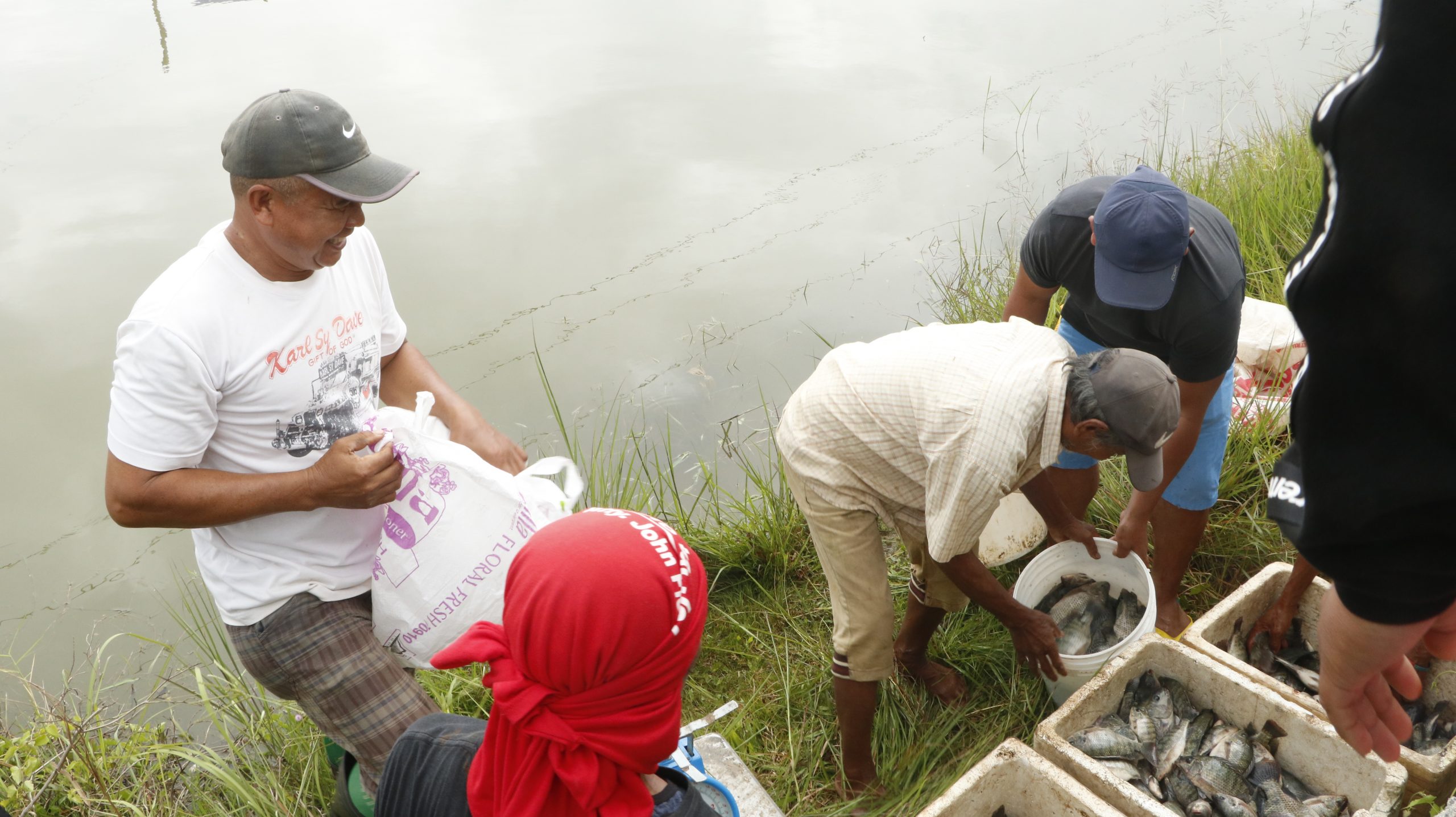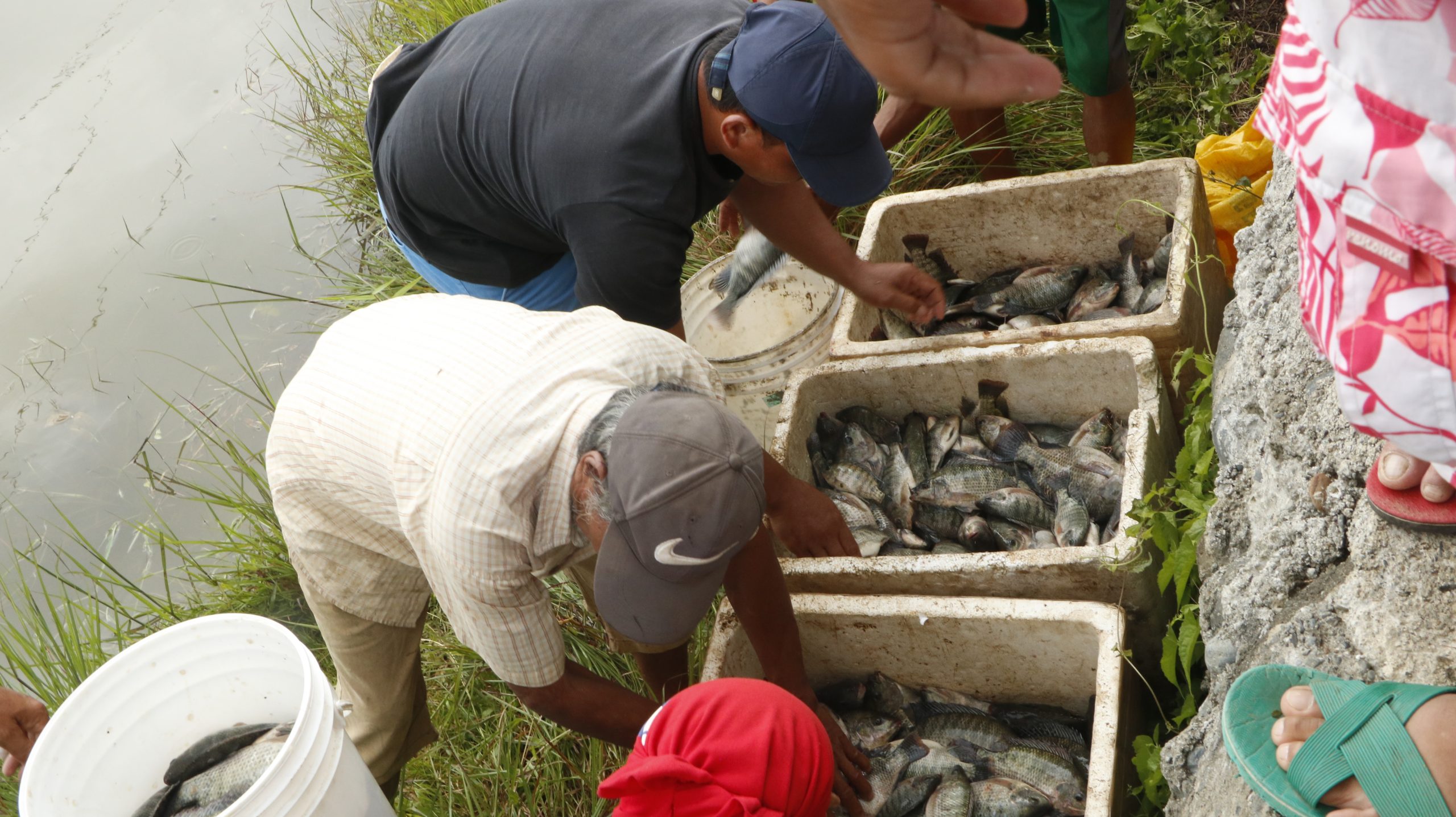CABANGLASAN, BUKIDNON, April 23, 2021 – Cabanglasan Farmer’s Small Water Irrigation System Association Inc., (CASWIMBA) harvested 762 kilograms (kg) of tilapia sold at Php 100/kg, giving the group an income of Php 76,200.
CASWIMBA President Leonilo Arcadio said that they stocked the 4,802 tilapia fingerlings in their four fish cages (measuring 100 cubic meter each) in November 2020.
After five months of culture period, the members harvested the fish at 60% survival rate.
Several walk-in and local buyers went to their area and directly bought the fish.
Project Implementation
The group has received fishery inputs from the Special Area for Agricultural Development (SAAD) Program since 2018 which includes the installation of the four units of fish cage and tilapia fingerlings.
|
Table 1. CASWIMBA Interventions Received |
||||
|
Supplies |
Cost | UOM | Quantity |
Total Cost (Php) |
|
2018 |
||||
|
Bamboo Poles 5-6” dia; full length |
200 |
pc |
120 |
2,400 |
|
PE Net 400/12x14k x100 MD |
11,000 |
bundle |
8 |
88,000 |
|
Plastic Drum |
2,500 |
unit |
32 |
80,000 |
|
Nipa/Cogon |
150 |
bundle |
2 |
300 |
|
Epoxy (A&B) |
620 |
pair |
2 |
1,240 |
|
PE Rope No. 12 |
900 |
Roll |
8 |
7,200 |
|
Plastic Shuttle (big) |
15 |
piece |
200 |
3,000 |
|
B-net, single width |
4,600 |
bundle |
1 |
4,600 |
|
PE Rope no. 12 |
900 | roll |
8 |
7,200 |
|
Nylon Twine 210/15 black dyed and resined |
310 |
spool |
4 |
1,240 |
|
Mononylon; 180 lbs |
435 |
kg |
20 |
8,700 |
|
Flashlight, HD-Chargeable |
3,800 |
unit |
1 |
3,800 |
|
Weighing Scale, 1 kg cap. |
350 |
unit |
1 |
350 |
|
Basin, 20 in. diameter, plastic |
650 |
pc |
2 |
1,300 |
|
Pail, 15L cap. plastic |
500 |
pc |
2 |
1,000 |
|
*Tilapia Fingerlings @ size # 17 |
pc |
12,000 |
||
|
Tilapia Fry Mash; 33% CP 10 kgs/bag |
400 |
bag |
4 |
1,600 |
|
Tilapia Starter Crumbles, 33% CP; 20 kgs/bag |
840 |
bag |
16 |
13,440 |
|
Tilapia Starter Pellets; 33% CP; 20 kgs/ bag |
840 |
bag |
16 |
13,440 |
|
Tilapia Grower Pellets; 28% CP; 25 kgs/bag |
810 |
bag |
60 |
48,000 |
|
Subtotal |
286,810 |
|||
|
2019 |
||||
| *Tilapia Fingerlings @ size # 17 |
pc |
12,000 |
||
|
Tilapia Fry Mash; 33% CP 10 kgs/bag |
400 |
bag |
4 |
1,600 |
|
Tilapia Starter Crumbles, 33% CP; 20 kgs/bag |
860 |
bag |
16 |
13,440 |
|
Tilapia Starter Pellets; 33% CP; 20 kgs/ bag |
860 |
bag |
16 |
13,440 |
|
Tilapia Grower Pellets; 28% CP; 25 kgs/bag |
840 |
bag |
60 |
50,400 |
|
Subtotal |
79,600 |
|||
|
2020 |
||||
|
*Tilapia Fingerlings, size 17 |
pc |
12,000 |
||
|
Tilapia Fry Mash; 33% CP 10 kgs/bag |
420 |
bag |
4 |
1,680 |
|
Tilapia Starter Crumbles, 33% CP; 20 kgs/bag |
860 |
bag |
16 |
13,760 |
|
Tilapia Starter Pellets; 33% CP; 20 kgs/ bag |
860 |
bag |
16 |
13,760 |
|
Tilapia Grower Pellets; 28% CP; 25 kgs/bag |
810 |
bag |
60 |
48,600 |
|
Subtotal |
77,800 |
|||
|
Grand Total |
444,210 |
|||
*The tilapia fingerlings were provided under the Technology Outreach Station (TOS) of BFAR regular program. Each year, the group has one production cycle.
In 2018, they earned Php 76,721 from selling 790.21kg of tilapia while in 2019, they had a return income of Php 67,700 from selling 677kg.
In total, the group had a gross earning of Php 220,621 and a net income of Php 60,000, which they saved up to sustain the project.
According to Leonilo, their only problem is the survival rate of the tilapia which usually is at 50-60%.
Provincial SAAD Focal Person Alfonsus Gonzaga suggested putting the tilapia fingerlings in a pond first. Once they grow bigger, the fish are recommended to be transferred in the cages to have an assured 80% survival rate.
The association is now looking for an area from one of the members for the pond culture.
Leonilo said that their income this year will be allocated for the development of the group’s tilapia nursery in the pond.
“Mao ng ako manghinaot nga ang maong project magpadayon kay dili lang ang association ang makabenepisyo, apil ang dili myembro nga dool sa among area. Makatabang gyud kayo siya nga project. Mao ng utrohon nako pagpangayo nga magpadayon pa unta ni nga project ug dili lang kaning fish cage and among mahibal-an paghimo kundi madugangan pa sama sa pagbuhat sa tilanggit, pag produce ug fingerlings, hangtud pagbuhat sa feeds. Kay arun kung mawala ang project sa gobyerno, naa gyapon ni nga project na among ma-sustain kay ang giuna nila nga gihatag pwede naman namo himoon nga puhonan kay naa man gyud income. So, amo tong gamiton para ma-sustain ang project, dili namo na gamiton sa maskin unsa lang,” said Leonilo.
(I hope that this project will continue because it is not just us, the association, who will benefit but also those non-members near our area. This is a big help to us. My unending thanks to the project and I hope that we can also learn other value-adding products out of tilapia like tilanggit making, how to grow tilapia fingerlings, and how to produce feeds. So that when this project will end, we can still sustain. Our net income from the first production cycle will be utilized for this project and not for other purposes.)
Also, the group plans to engage in processing value-added products like lamayo (half-dried tilapia) and tilanggit to achieve zero post-harvest loss.
Gonzaga said that he will provide training on how to make tilanggit and lamayo.
“Dako kayo ug katabang sa mga tao diri kanang mga naharvest nga mga isda. Nalipay kayo ang mga miyembro, bisan kadtong dili mga miyembro malipay usab kay makapalit man silag mga dagko nga isda, lab-as pa gayud. Sa taga DA ug sa taga BFAR, daghan kaayong salamat. Hinaot unta nga magpadayon kining SAAD nga programa,” said Epifanio Valencia, member of Cabanglasan Farmer’s Small Water Irrigation System Association.
(The harvested tilapia is a big help for the people in this area. We, members are very happy, also those who are not members because they can buy fresh fish harvest. To DA and BFAR, our endless thanks. We hope that the SAAD Program will continue.)
“Kaniadto lisod kayo magpalit ug isda tungod kay layo mi sa syudad, pero tungod sa SAAD, nakahimo kami ug Freshwater Fish Cage. Inubanan sa kakugi ug pagpaningkamot sa mga miyembro sa asosasyon, naka harvest na mi, ug nakita na gayud namo among hinaguan. Daghan salamat sa BFAR ug labi na sa SAAD nga programa sa gobyerno,” added Emilia Pardillo, also a member of the association.
(Before, it was very difficult for us to buy fish because we are far from the town. But because of SAAD, we were able to make Freshwater Fish Cage. Through hard work and perseverance of the group members, we started to harvest our tilapia. Thank you very much to BFAR, especially to the SAAD Program of the government.)
The group will prepare for the next production cycle and the implementation of tilapia fingerlings culture in the pond. ###
Writer: Jennifer Valcobero, SAAD NPMO Public Relation and Comms Officer
Source of Photos: BFAR Region 10










Comments (0)